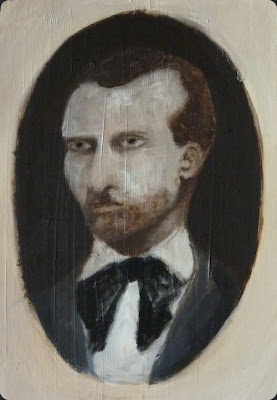Miroslaw Patecki, Christ the King
This year Berlin
held its 7th Biennale. Begun in 1998 it has seen Berlin emerge as
one of the art capitals of the world. The 7th Biennale had people
talking as soon as the infamous Artur Zmijewski was said to be curating the
show. The Warsaw born curator is known
as much as for his ego, as for his
provoking, uncompromising artwork. His
manifesto The Applied Social Arts in
which questions such as ‘Does art have any political significance’ and ‘can art
change reality’ formed the point of departure for the 7th Berlin
Biennale.
With the heavy
political theme running throughout, it
was always going to be an exhibition which provoked and infuriated some, and at
the very least made you react. I reacted as soon as I entered the corridor
leading up to the first floor of the Kunst – Werke Institute for Contemporary
Art. The ground floor had been taken over by the occupy movement (invited by
Zmijewski) and for this reason the corridors and stairs were covered in stencil
art, and signs put up with peeling pieces of gaffer tape, and scrawled
messages. If you wanted the antithesis of a ‘white cube’ space, or exhibition,
this was it.
The first floor saw
the space being taken over by a huge head of Jesus, created by Miroslav
Patecki. The head was a replica of the one that he created for the Christ
statue, Christ the King in
Swiebodzin, Poland. Patecki had been working on the polystyrene head throughout
the exhibition with part of the gallery space as his workshop. I saw it in its
final guise and I couldn’t take it in. The piece was meant to display ‘a
perfect face of Christ’, although the disembodied head did little to enlighten
my Christian leanings, especially as it was topped with a shoddily made crown
which seemed several sizes too big. I feel that I would have gained more than
simply bemusement from the piece if I had seen the piece whilst being
made. In its completed state alongside
the empty studio space it looked like an oversized prop for a theatre.
PM 2010,a work by Teresa Margolles a year’s
supply of the tabloid newspaper
covers published in one of the most dangerous
border cities in Mexico. The majority of the pages displayed grainy pictures of
fatally shot victims in blood smeared clothing, and next to this, bare breasted
models. This juxtaposition of the images seemed too absurd to be true and yet
they were.
In response to Margolles
installation, Antanas Mockus, former Mayore of Bogota and political thinker
created a piece titled Blood Ties.
For the piece he asked people to donate a drop of their blood and choose to
sign a legal waiver stating that they would not consume drugs during the Berlin
Biennale as a statement against the Mexican drug wars. In conjunction to this a
Mexican flag and book were placed on a lever over a bucket of liquid. When
people signed the waiver and donated their blood the flag and book were hoisted
into safety. When I viewed Blood Ties
the flag and book were dipped in the pool of liquid, sodden and water damaged.
Apparently due to health and safety regulations visitors were no longer allowed
to give blood and thus the piece had stalled, leaving the sodden flag and book
dipped in the liquid, and a table messy with the signed declarations of the
waiver.
On the top most floor of the KW housed Polish artist, Lukasz
Surowiec’s project, Birke. Surowiec had taken Birch Tree saplings from the Nazi
concentration camp, Auschwitz-Birkenau and had planted them throughout Berlin,
including two in the courtyard of the KW. The viewer was greeted with tables upon
which pots of birch seedlings rested under bright lights, ready to be taken
away by the visitor and planted wherever you chose. In a darkened room a video
also showed the process of removing the saplings from Auschwitz and then
replanting them around Berlin. I found
the idea behind the piece to be beautiful, and there was something moving about
seeing the two saplings out in the courtyard on a grey wet day, their thin
branches fighting against the wind that made me conclude, that although not all
the works exhibited fufill Zmijewski’s manifesto, ones like Birke certainly leave the world a more eloquent, thought provoking
place.




.jpg)









